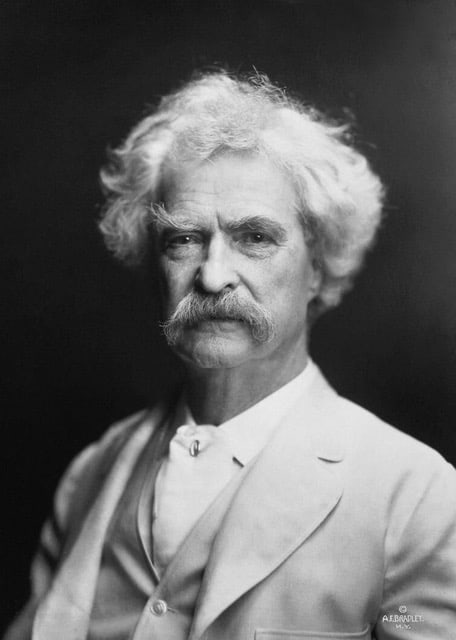
Mark Twain lived in Yonkers for a year
By Mary Hoar, City of Yonkers Historian, President Emerita Yonkers Historical Society, recipient of the 2004 Key to History, Member of the Yonkers Landmarks Preservation Board, and President Untermyer Performing Arts Council
Monday, October 30th
October 30, 1919: The Knights of Columbus held a benefit dance at St. Mary’s for their proposed veterans’ home; noted song writer Victor Nurnberg introduced several of his latest hits, sung by New York City singers A. Mac Alanen and Ralph Conlon. Parishioners of Sacred Heart held a benefit at the Chippewa Club to support the effort; these two events brought the total of pledges to $76,000.
October 30, 1943: Cliffcrest at 523 Riverdale Avenue, once rented by Mark Twain and his family for a year, was formally dedicated as a home for seamen of the United Nations. The new unit, run by the Manhattan unit of the American Women’s Hospitals Reserve Corps (AWHRC), was named the Gloryhole. The historic house was converted into a modern country home to provide rest and recreation for seamen on sick leave or furlough. Major Rosalind Cowen, Director of the AWHRC, officiated at the ceremony; William Ruxton, former president of the British-American Ambulance Corps, was master of ceremonies.
Tuesday, October 31st
October 31, 1912: Mrs. Corinne Knickerbocker presented a life-size bust of George Washington to Mayor Lennon for the City of Yonkers. Created by the late Wilson MacDonald, it was a replica of Houdon’s life mask of Washington, molded directly from Washington’s face in 1785. MacDonald made many castings of this bust, numbered them and wrote on the back, “This is a mathematical reduction of the original Life Mask Bust of Washington, sworn to by Wilson MacDonald, Copyright 1899, The Menry-Bonnard Bronze Co, Founders NY 1899.”
October 31, 1935: An earthquake that shook 17 states and Eastern Canada hit Yonkers. Although no real damage resulted from the quivers felt in Yonkers, thousands jumped out of bed in panic.
October 31, 1945: A bit of role playing by a victim led to a bandit incriminating himself! Detectives William Harding and Louis Ligay caught William Holmes with a loaded revolver at the USO the day before. They told butcher shop owner Angelo Colacurcio to dress and act like a plainclothes policeman, walk into the Detective Division and hand Harding a typewritten paper, saying, “You left this downstairs.” Harding thanked him, calling him Tom. To everyone’s astonishment, Holmes shouted, “Cut out the comedy! His name ain’t Tom. He’s the guy we stuck up!”
Wednesday, November 1st
November 1, 1899: The November Argosy featured the opening chapters of “The American Syndicate,” a novel by Frederick Burton of Yonkers. The story tells the experiences of a New Yorker who heads to Puerto Rico with $33 in his pocket and a signboard to undertakes big business schemes.
November 1, 1913: The Yonkers Camera Club opened its new clubrooms in the Hollywood Inn, fully equipped with a dark room and other photographic facilities.
November 1, 1929: Overcome by her admiration for Alvin “Shipwreck” Kelly’s pluck, a twenty-two-year-old telephone operator prevailed upon the flagpole sitter’s attendants to hoist her up to his side on top of the Proctor Building and rewarded him with a kiss, while the crowd below cheered.
Thursday, November 2nd
November 2, 1925: Yonkers offered to settle a tax lien of $36,991 for $17,000 plus arrears of taxes on the William Boyce Thompson Institute of Plant Research.
November 2, 1927: Fire destroyed one of the few remaining farmhouses in Yonkers. The fire left the house at 77 Mile Square Road in ruins; the only animal on the farm was rescued, a cow owned by Louis Tishkowitz.
Friday, November 3rd
November 3, 1919: The total collected for the K of C Memorial Hut Drive for wounded veterans rose to more than $81,000; the campaign was halted until November 11th, so the drive would not compete with the Red Cross Roll Call for membership.
November 2, 1926: Yonkers voters indicated by a ratio of five-to-one they favored modification of the Prohibition Amendment. 15,499 voted in favor of change, while 3,630 voted against it.
November 3, 1935: More than half of the 60,000 registered Yonkers voters had cast their ballot by noon.
Saturday, November 4th
November 19, 1919: Yonkers Superintendent of Buildings announced he had received a request to rent the old Armory Building from Wilbur Dyer & Company; they offered $3600 annually for a four-year-lease. The Committee on Public Buildings would study the offer, and report back.
November 4, 1944: City Manager William Walsh refused to resign his position; three council members—Mayor Curtiss Frank and Councilmembers Edith Welty and John Whalen—had offered him the choice of resigning or face termination for what they called his lack of “energetic approach to municipal budgets.” Walsh told them they should, “Take the usual procedure, as I want to tell the whole world about this, and I certainly intend to do so.”
Sunday, November 5th
November 5, 1923: Yonkers Communists ran their red flag and banner over our City Hall in the dead of night; their banner commanded “Cash relief. Vote Communist!”
November 5, 1936: Justice William F. Bleakley of Yonkers suffered a defeat in his run for governor as a record shattering New York vote for President Roosevelt swept Governor Herbert Lehman back into office.
November 5, 1942: Approximately two hundred workers on two 10-hour shifts at the Arthur G. Blair shipyards on Alexander Street began converting a 225-foot ship for war use. The ship would be protected against magnetic mines.
Questions or comments? Email YonkersHistory1646@gmail.com.
For information on the Yonkers Historical Society, Sherwood House and upcoming events, please visit our website www.yonkershistoricalsociety.org, call 914-961-8940 or emailinfo@yonkershistoricalsociety.org.
…





